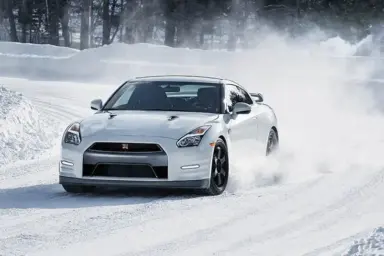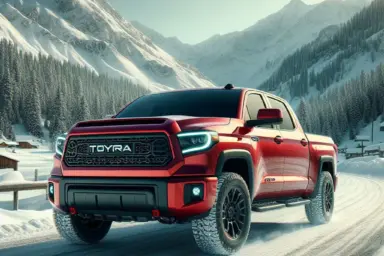Front-wheel drive(FWD) is an engine and transmission design that drives only the front wheels in motor vehicles.
If you are wondering whether you can drive a front-wheel drive car in the snow, you are in the right post! Front-wheel drive cars are safe if you drive them correctly.
So we will discuss the different ways to make your FWD car better in snowy conditions, how to drive it on snow and which drivetrain is best for winter weather.
Let’s understand more.
Table of Contents
Are Front-Wheel Drive Cars Bad in the Snow?
Front-Wheel Drive is just fine for snow or icy roads. It can handle snow as long as you drive carefully. Most weight is directed above the front tires, so the drivetrain gets good traction.
Since the weight is above or behind the wheels that steer the car, the FWD transmission pulls the vehicle forward and cuts down the oversteer.
Oversteering is the leading cause of cars spinning in the snow, and it is best if the car’s tires are winter-friendly. All-weather tires don’t do well in snow.
How to Make FWD Cars Better in the Snow?

If you are moving to a snowy area or just visiting, you will want to understand how to make your FWD easier to drive on snow. This is how you can improve the chances of getting to your destination safely without compromising comfort.
- Fitting Winter tires
Winter tires are one of the best things to help you survive the snow. Fitting these tires improve your safety margin and reduce anxiety on snow-covered roads.
They are built with grooves and siping that provide maximum contact with the road, allowing better traction and handling of the car.
- Snow chains
Snow chains offer a good grip on deep snow. They are fitted to the drive wheels and swing under the tires automatically, increasing traction.
- Tire socks
Tire socks, also referred to as snow socks or auto socks, act as the contact point between the vehicle and the road. They are best suited in a light snow to increase traction. They are made from woven fabric with elastomer in the inner edges.
How do you Drive FWD on Snow?
Driving an FWD car in snowy conditions is quite easy. With a few tips, you will stay safe and avoid dangerous scenarios with your vehicle. These tips include:
- Avoid Sudden and Quick Movements
You should always avoid sudden movements while moving along. Steering too fast or slamming on the brakes can make your car spiral out of control. You can anticipate trends to ease them rather than stumble on them in the last moments.
- Don’t Stop the Car
Refrain from tapping onto your brakes when driving on snowy roads, especially when you drive on hilly roads that are covered by snow. This allows you to use all the FWD abilities the car has.
Moreover, tapping brakes could lead to loss of traction on ice, loss of control of your vehicle, or even loss of ability to stop. If you approach a stop sign, it will be easier when you are light on brakes.
- Anticipate what Next
You should always anticipate ahead. Watch out for shiny or dull surfaces that indicate the presence of black ice, the type of snow since others are easier to drive over, and water, which could cause slipping.
- Avoid thick Snow
Front-wheel drives are great on thin snow. They are only adept with 6 feet of snow.
- Avoid Oversteering
If your car drifts in snow, it is best to refrain from panicking. If nature pulls the car, do not attempt to correct the movement. Instead of oversteering, ride it out and turn the car slowly after some time. Turning too fast and too early can make you slip off the road.
What is Drive Best for Snow? (AWD vs 4WD vs FWD vs RWD)
Different drivetrains act differently on snow. Let us understand how these drivetrains perform on snow:
All-wheel drive (AWD)
AWD is considered the best type of drive for snow. It provides power to all four wheels of the car, making it easier to control it on slippery surfaces.
The car’s weight is evenly distributed, increasing stability and traction. If one wheel slips, the others can help it out.
Part-time AWD is also available and sends torque to the front and back when the other wheels are automatically engaged when more traction is needed.
Four Wheel Drive (4WD)
The 4WD system has continuously driven wheels that send torque to all the wheels to increase traction even in deep snow.
It has part-time 4WD that lets you operate the vehicle in 2WD mode. The 2WD modes either have a low or high range.
The high range is best for snowy, icy conditions, while the low range handles off-road environments better.
Front-wheel drive (FWD)
The front-wheel drive delivers power to the front wheels. The FWD cars have better fuel economy and maintain good traction over light snow or ice.
Rear-wheel drive (RWD)
RWD cars send torque to the back wheel, boosting traction. The RWD is not the best choice for driving in the snow. They tend to spin out and lose traction quickly.
However, if you must drive an RWD car in the snow, go slowly and avoid sudden movements. Apply light pressure on the gas pedal to prevent sliding.
So, Which Drive is most suitable For Snow?
The All-wheel drive(AWD) is best for driving in snow. If the snow is too thick, the 4WD is the best choice. The FWD, on the other hand, performs best in light snow. The RWD is not the best choice for snowy roads.
Final Words
Yes, you can drive a front-wheel drive car in the snow. The weight in an FWD is either behind or above the wheels, pulling the vehicle forward. This prevents oversteering, which causes spinning in the snow.



